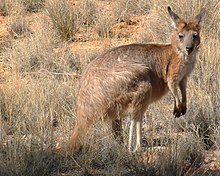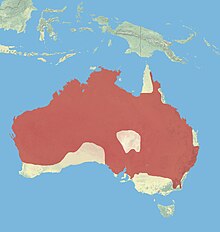The common wallaroo (Osphranter robustus), also known as the euro, hill wallaroo, or simply wallaroo,[2] is a species of macropod. The word euro is particularly applied to one subspecies (O. r. erubescens).[3]
| Wallaroo[1] | |
|---|---|

| |
| Euro (Osphranter robustus erubescens) | |
| Scientific classification | |
| Domain: | Eukaryota |
| Kingdom: | Animalia |
| Phylum: | Chordata |
| Class: | Mammalia |
| Infraclass: | Marsupialia |
| Order: | Diprotodontia |
| Family: | Macropodidae |
| Genus: | Osphranter |
| Species: |
O. robustus
|
| Binomial name | |
| Osphranter robustus Gould, 1841 | |
| Subspecies | |
| |

| |
| Common wallaroo range | |
The eastern wallaroo is mostly nocturnal and solitary, and is one of the more common macropods. It makes a loud hissing noise and some of the other subspecies are sexually dimorphic, like most wallaroos.[4]
There are four subspecies:[1]
The eastern wallaroo (O. r. robustus)—which is dark grey in colour—occupies the eastern slopes of the Great Dividing Range, and the euro (O. r. erubescens)—which is mostly brownish in colour—occupies the land westward.
Wallaroo females can give birth at any time during the year. Through a process called embryonic diapause they are able to get pregnant any time after giving birth, but the embryo does not start to develop until the previous joey is able to leave the pouch of the mother. Wallaroos are also polygynous, which means that the males can have multiple female partners.[7]
Male wallaroos will engage in non-deadly physical combat over mating access to females.[8]
The gestation period lasts around 30 to 38 days, after which the young joey travels into the mother's pouch where it suckles and develops.[7] The young joeys start to leave the pouch at around six months and by nine months they no longer spend most of their time in the pouch.[9] Male wallaroos are fully developed at around 18 to 20 months; females are fully developed at around 14 to 24 months.[7]
The relationship with the joey and their parents changes as the joey grows and gets older. During the time in which the joey is in the pouch, the father stays around to protect the joey and mother from predators, but once this protection is no longer needed the relationship weakens between the two. After the joey no longer needs its mother for food, it still maintains a close relationship with her.[8]
The eastern wallaroo as a subspecies is not considered to be threatened, but the Barrow Island subspecies (O. r. isabellinus) is classified as vulnerable.[2]
In 2019, a reassessment of macropod taxonomy determined that the species should be moved from the genus Macropus to the genus Osphranter.[10] This change was accepted by the Australian Faunal Directory in 2020.[11]